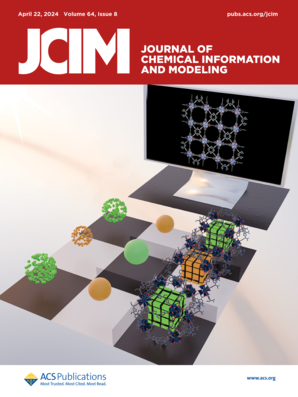分子动力学模拟与机器学习的结合揭示了合成单菌基甘油类似物立体化学特异性交叉的结构特征。
IF 5.6
2区 化学
Q1 CHEMISTRY, MEDICINAL
引用次数: 0
摘要
合成的单菌酰甘油(MMG)类似物具有强大的免疫刺激活性,并在临床前和临床研究中作为亚单位疫苗的佐剂进行了研究。这些合成脂质由附着在伞藻酸上的甘油部分组成。先前的实验研究表明,在主相变温度(Tm)以下,脂质酸部分的立体化学会影响MMG类似物自组装成交叉或非交叉结构。在这项研究中,我们通过结合机器学习(ML)和分子动力学(MD)模拟来探索MMG类似物的构象、相互作用和动力学,阐明了控制MMG类似物相行为的可能热力学机制。我们比较了两种类似物,MMG-1和MMG-6,它们只是在脂质酸部分的立体化学上有所不同;前者具有不同于天然MMG的构型,后者具有类似天然MMG的立体化学。模拟了三种不同的膜状态:(1)非交叉的单双分子层,(2)非交叉的双分子层,(3)完全交叉的双分子层。我们的结果表明,双分子层中MMG类似物的互指倾向与它们的烃链有序和定向的程度有关。本研究展示了如何将MD模拟与ML相结合可以增强对基于脂质的药物配方的分子理解。本文章由计算机程序翻译,如有差异,请以英文原文为准。
Combination of Molecular Dynamics Simulations and Machine Learning Reveals Structural Characteristics of Stereochemistry-Specific Interdigitation of Synthetic Monomycoloyl Glycerol Analogs.
Synthetic monomycoloyl glycerol (MMG) analogs possess robust immunostimulatory activity and are investigated as adjuvants for subunit vaccines in preclinical and clinical studies. These synthetic lipids consist of a glycerol moiety attached to a corynomycolic acid. Previous experimental studies have shown that the stereochemistry of the lipid acid moiety affects whether the MMG analogs self-assemble into interdigitated or noninterdigitated structures below the main phase transition temperature (Tm). In this study, we elucidated possible thermodynamic mechanisms governing the phase behavior of MMG analogs by exploring their conformations, interactions, and dynamics using a combination of machine learning (ML) and molecular dynamics (MD) simulations. We compared two analogs, MMG-1 and MMG-6, which differ only by the stereochemistry of the lipid acid moiety; the former has a configuration different from the natural MMG, and the latter displays a native-like stereochemistry. Three different membrane states were simulated: (1) a noninterdigitated single bilayer, (2) a noninterdigitated double bilayer, and (3) a fully interdigitated double bilayer. Our results indicate that the propensity for interdigitation of the MMG analogs in a bilayer is linked to the degree to which their hydrocarbon chains are ordered and oriented. This study demonstrates how combining MD simulations with ML can enhance the molecular understanding of lipid-based pharmaceutical formulations.
求助全文
通过发布文献求助,成功后即可免费获取论文全文。
去求助
来源期刊
CiteScore
9.80
自引率
10.70%
发文量
529
审稿时长
1.4 months
期刊介绍:
The Journal of Chemical Information and Modeling publishes papers reporting new methodology and/or important applications in the fields of chemical informatics and molecular modeling. Specific topics include the representation and computer-based searching of chemical databases, molecular modeling, computer-aided molecular design of new materials, catalysts, or ligands, development of new computational methods or efficient algorithms for chemical software, and biopharmaceutical chemistry including analyses of biological activity and other issues related to drug discovery.
Astute chemists, computer scientists, and information specialists look to this monthly’s insightful research studies, programming innovations, and software reviews to keep current with advances in this integral, multidisciplinary field.
As a subscriber you’ll stay abreast of database search systems, use of graph theory in chemical problems, substructure search systems, pattern recognition and clustering, analysis of chemical and physical data, molecular modeling, graphics and natural language interfaces, bibliometric and citation analysis, and synthesis design and reactions databases.

 求助内容:
求助内容: 应助结果提醒方式:
应助结果提醒方式:


